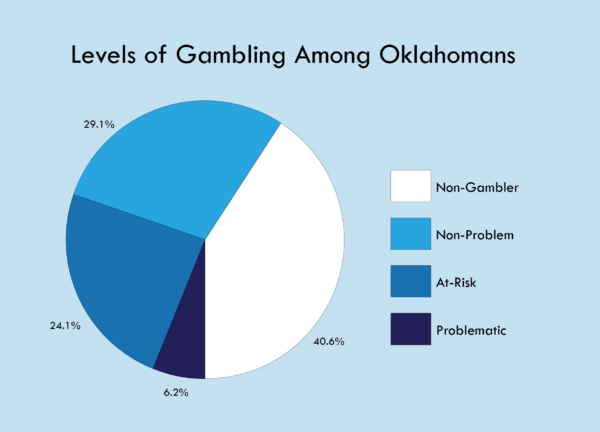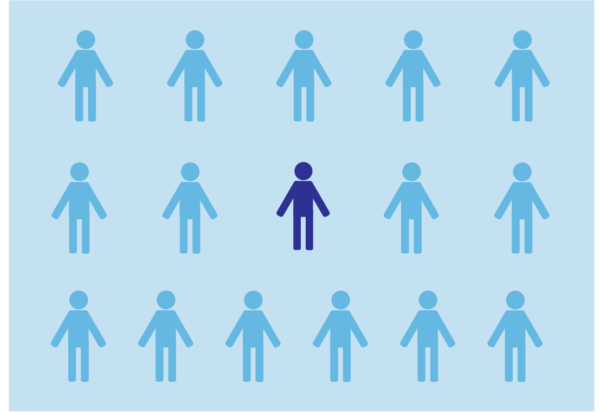2022 PROBLEM GAMBLING PREVALENCE STUDY
From April through August of 2022, Elite Research conducted a survey on behalf of OAPGG to measure the prevalence of problem gambling in the state of Oklahoma. The survey was conducted both online and through telephone interviews, with 4,050 adults over 18 surveyed. The collected data has been analyzed by Dr. Devin Mills and his research team at Texas Tech University. Read the full report.
EXECUTIVE SUMMARY
The landscape of gambling is changing across the US, with a noticeable increase in both sports betting and online gambling. While a 2016 study identified 56.4% of Oklahoma adults engaged in gambling during the previous and that 3.2% met the criteria for gambling disorder (GD), this rapidly changing landscape necessitated an updated study to assess the prevalence of gambling and gambling disorder in Oklahoma. Below is a summary of our findings from a sample of 4,035 adults in Oklahoma.
Gambling Participation:
• 57.9% of Oklahomans partake in some form of gambling each year.
• 20.1% are low-frequency (i.e., less than monthly), 19.0% are moderate frequency (i.e., monthly), and 17.7% are high-frequency (i.e., weekly or more).
Gambling Disorder:
• 6.3% are met criteria for GD, with a further 23.5% At-Risk for GD, implying that around 200,000 Oklahoman adults may have a GD diagnosis, and an additional 700,000 are at risk for GD.
• The prevalence of GD was higher among moderate-frequency (11.0%) and high-frequency individuals (21.9%).
• The highest proportions of GD were found among those participating in daily fantasy sports (22.2%), followed by racetrack betting (19.3%), stock trading (16.3%), and slot and video card machines (16.2%).
• 18.4% of those meeting the criteria for GD had seriously contemplated suicide due to gambling, and 23.2% had attempted suicide.
Helpline and Resources:
• Despite the availability of a helpline, awareness of treatment options for GD remains low, with a small percentage of individuals who gamble, including those at significant risk for GD, utilizing the helpline. Urgent action is required to increase awareness of and access to treatment options to mitigate the escalating social and personal costs of GD in Oklahoma.

What percentage of Oklahomans are gambling?
59.4% of Oklahomans have gambled in the past year. This percentage includes the players who are either non-problem, at-risk, or experiencing a problem.
What percentage of Oklahomans are experiencing problem gambling?
1 in 16 (6.2%) Oklahomans meet criteria for gambling disorder. 24.1% of Oklahomans are at-risk for problem gambling. Taken together, 30.3% of Oklahomans are in need of some form of harm prevention, intervention, or treatment.


What is the most common symptom of problem gambling among Oklahomans?
Of the 9 criteria listed in the DSM-5, Oklahomans were mostly like to endorse criterion 8, experiencing interpersonal problems with a spouse/partner, important friend, or family due to gambling.
Do men and women have equal rates of problem gambling?
Males have a higher rate of at-risk classification, with 29.1% of males being at risk relative to 19.3% of females. About 6.6% of males and 5.8% of females meet the criteria for gambling disorder.


What age group is most at risk for a gambling problem?
The prevalence of problem gambling is highest for the 25-44 age group, at 8.7%. The under 25 age group and the 45-64 age group had similar rates, at 5.8% and 5.6%, respectively. The 65+ age group has the lowest rate of problem gambling at 2.8%.
How does racial background impact problem gambling rates?
Black or African Americans have the higher percentage of problem gambling (8.3%). Those who are of Hispanic, Latino, or Spanish origin have a significantly lower percentage of problematic players (2.6%) compared to those who are not of Hispanic, Latino, or Spanish origin (6.5%).


Does education or employment affect problem gambling and at-risk rates?
The proportion of at-risk players with less than a college degree (25.9%) is significantly higher than those with a college degree or more (21.9%), and the proportion of problematic players with less than a college degree (7.2%) is also higher than those with a college degree or more (4.9%).
At-risk and problematic play rates are higher for those who are employed (26.6% and 21.2%, respectively) compared to those who are not employed.
